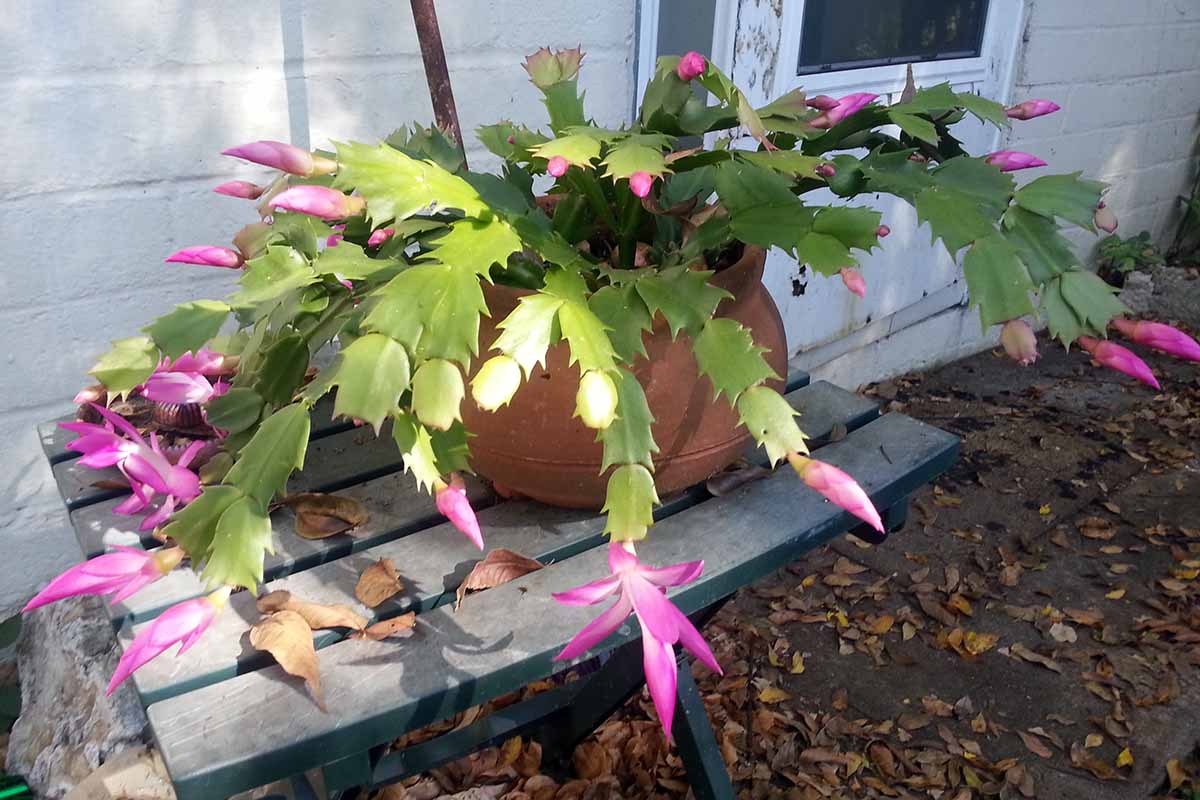Contents
- 1 Can You Grow the Thanksgiving Cactus Outdoors?
- 2 FAQ
- 2.1 Can you grow a Thanksgiving cactus outdoors year-round?
- 2.2 What temperature range is best for growing a Thanksgiving cactus outdoors?
- 2.3 Does the Thanksgiving cactus need full sun outdoors?
- 2.4 What type of soil should I use for outdoor Thanksgiving cacti?
- 2.5 How often should I water my outdoor Thanksgiving cactus?
- 2.6 How much humidity does an outdoor Thanksgiving cactus need?
- 2.7 Can I leave my Thanksgiving cactus outdoors during the winter?
- 2.8 What are common pests and diseases for outdoor Thanksgiving cacti?
- 2.9 How do I fertilize my Thanksgiving cactus outdoors?
- 2.10 Should I prune my outdoor Thanksgiving cactus?
- 2.11 Conclusion
Can You Grow the Thanksgiving Cactus Outdoors?
The Thanksgiving Cactus is a popular holiday plant known for its vibrant blooms and unique, segmented stems. While it’s typically grown as an indoor plant, many gardeners wonder if it can thrive outdoors. The short answer is yes, but with some caveats. Here’s what you need to know:

Climate Considerations
Thanksgiving cacti are native to the tropical rainforests of Brazil, where they thrive in humid, warm environments. These conditions should be replicated as closely as possible if you’re considering growing your cactus outdoors.
- USDA Hardiness Zones: 9-11
- Ideal Temperature Range: 60-70°F (16-21°C)
- Minimum Temperature: 50°F (10°C). Exposure to temperatures below this can cause significant damage to the plant.
If you live in an area with mild winters and no frost, your Thanksgiving cactus may thrive outside year-round. However, in colder regions, you’ll need to bring the plant indoors before temperatures drop.
Sunlight Requirements
Thanksgiving cacti require bright, indirect sunlight to flourish outdoors. Direct sunlight, especially during the hottest parts of the day, can scorch the plant’s leaves, so it’s crucial to find the right balance.
- Best Location: A spot with morning sun and afternoon shade or filtered light all day long is ideal.
- Avoid: Full exposure to direct sun for extended periods, particularly during peak daylight hours.
If the plant is getting too much sunlight, its leaves may turn red or purple, a sign of stress.
Soil and Watering Needs
A well-draining soil mix is essential for the Thanksgiving cactus to prevent root rot. Outdoors, you can use a potting mix specifically designed for succulents or cacti, which helps with drainage.
- Soil Mix: A combination of regular potting soil with added sand or perlite will work well.
- Watering: The key is to keep the soil consistently moist but not waterlogged. Water when the top inch of soil feels dry. Be cautious not to overwater, especially during cooler periods.
Humidity Levels
Thanksgiving cacti prefer a more humid environment, mimicking their tropical origins. If your outdoor conditions are dry, you’ll need to increase humidity levels to keep the plant happy.
- Optimal Humidity Range: 50-60%
- Tips: Place a tray of water near the plant to naturally boost humidity or use a humidifier during dry spells.
Maintaining the right humidity can be challenging outdoors, but with the right setup, your Thanksgiving cactus will thrive.
Fertilization
To encourage growth and blooming, fertilize your Thanksgiving cactus during its active growing season (spring and summer).
- Fertilizer Type: A balanced, water-soluble fertilizer like 20-20-20 is ideal.
- Fertilization Frequency: Feed your cactus once a month during the growing season. Reduce fertilizing in the fall and winter when the plant enters its dormant phase.
Regular feeding will ensure that your Thanksgiving cactus remains healthy and produces those beautiful seasonal blooms.
Pests and Diseases
When grown outdoors, Thanksgiving cacti are more exposed to pests like aphids, mealybugs, and spider mites. Regular inspections will help you catch any infestations early.
- Pest Control: Use insecticidal soap or neem oil to combat common pests. If the infestation is severe, you may need to isolate the plant and treat it thoroughly.
- Disease Prevention: Ensure there is good air circulation around the plant to prevent fungal diseases, which can occur in overly humid or stagnant conditions.
Bringing Your Thanksgiving Cactus Indoors for Winter
If you live in a region where winter temperatures drop below 50°F (10°C), it’s crucial to bring your Thanksgiving cactus indoors before the cold weather arrives. Sudden shifts in temperature can shock the plant, so it’s best to acclimate it gradually.
- Acclimatization Process: Start by moving the plant to a shaded or protected outdoor area for a few days before bringing it inside. This will help it adjust to the reduced light and humidity levels indoors.
- Indoor Care: Place the cactus in a location that receives bright, indirect light and maintain its regular watering schedule. Remember to reduce watering during its dormant period in winter.
FAQ
If you’re wondering whether the vibrant and festive Thanksgiving cactus can be grown outdoors, you’re not alone. Many plant enthusiasts are curious about how this popular holiday cactus fares in outdoor environments. In this FAQ, we’ll explore the most common questions related to growing a Thanksgiving cactus outdoors and the best practices to ensure it thrives.
Can you grow a Thanksgiving cactus outdoors year-round?
Yes, but only in specific climates. The Thanksgiving cactus is native to tropical rainforests and prefers warm, humid conditions. If you live in USDA hardiness zones 9-11, where temperatures remain mild throughout the year, you can successfully grow your cactus outdoors year-round. However, in areas with cold winters, it’s necessary to bring the plant indoors before temperatures drop below 50°F (10°C), as it cannot survive frost or freezing conditions.
What temperature range is best for growing a Thanksgiving cactus outdoors?
The ideal temperature range for a Thanksgiving cactus is between 60-70°F (16-21°C). It can tolerate slightly cooler temperatures, but prolonged exposure to anything below 50°F (10°C) can harm the plant. If you’re growing your cactus outdoors, keep an eye on the forecast during colder months. Once temperatures begin to drop, move the cactus indoors to protect it from cold damage.
Does the Thanksgiving cactus need full sun outdoors?
No, Thanksgiving cacti thrive in bright, indirect sunlight, but they should not be exposed to full sun for long periods, especially during the hottest part of the day. In their natural habitat, these cacti grow under the canopy of trees, where they receive filtered light. The best outdoor location is one that gets morning sunlight but offers afternoon shade. Too much direct sun can scorch the leaves, turning them red or brown.
What type of soil should I use for outdoor Thanksgiving cacti?
Thanksgiving cacti prefer well-draining soil, similar to the type used for succulents or cacti. If planting your cactus outdoors in a garden bed or pot, use a soil mix designed for succulents or create your own by combining regular potting soil with sand or perlite. This mixture improves drainage and helps prevent root rot, which can be a problem if the plant sits in soggy soil for too long.
How often should I water my outdoor Thanksgiving cactus?
The watering schedule for your outdoor Thanksgiving cactus depends on the climate and season. Generally, you should water it when the top inch of soil feels dry to the touch. Avoid waterlogging the soil, as the Thanksgiving cactus is susceptible to root rot. During hotter months, you may need to water more frequently due to increased evaporation. However, in the fall and winter, when the plant is dormant, reduce watering significantly.
How much humidity does an outdoor Thanksgiving cactus need?
Thanksgiving cacti thrive in moderate humidity, ideally around 50-60%. In outdoor settings, particularly in dry climates, you may need to increase the humidity by misting the plant or placing a tray of water nearby to help maintain moisture in the air. If your outdoor area is especially dry, consider moving the plant to a more humid spot or providing additional humidity through other means.
Can I leave my Thanksgiving cactus outdoors during the winter?
Only if you live in a warm climate where winter temperatures do not drop below 50°F (10°C). Thanksgiving cacti cannot tolerate frost or freezing conditions, and exposure to cold temperatures can cause damage or kill the plant. In regions with cold winters, it’s best to bring your cactus indoors before the weather turns too cold. Gradually acclimate the plant to indoor conditions by first moving it to a shaded area outside for a few days.
What are common pests and diseases for outdoor Thanksgiving cacti?
When grown outdoors, Thanksgiving cacti can be vulnerable to pests such as aphids, mealybugs, and spider mites. Regularly inspect your plant for signs of pests, like discolored or sticky leaves. If you notice any infestations, treat the plant with insecticidal soap or neem oil. Outdoor cacti can also be susceptible to fungal diseases, especially if they are overwatered or don’t have enough air circulation. Ensuring good drainage and spacing between plants can help prevent these issues.
How do I fertilize my Thanksgiving cactus outdoors?
Fertilize your outdoor Thanksgiving cactus with a balanced, water-soluble fertilizer during the growing season (spring and summer). A formula like 20-20-20 works well. Apply fertilizer once a month during these active months. However, reduce feeding in the fall and stop fertilizing during the winter, as the plant enters dormancy.
Should I prune my outdoor Thanksgiving cactus?
Pruning isn’t necessary for the Thanksgiving cactus to thrive, but you can prune it to encourage bushier growth or to shape the plant. After it finishes blooming in late fall or early winter, use sterilized scissors or shears to remove any segments at the joints. This can also help remove dead or unhealthy sections of the plant.
Conclusion
So, can you grow a Thanksgiving cactus outdoors? Absolutely, as long as you live in a suitable climate or are prepared to bring it indoors during colder months. By paying attention to temperature, light, and moisture, your outdoor Thanksgiving cactus can thrive and bring vibrant blooms to your garden or patio.
following these guidelines, you can enjoy the beauty of this festive cactus both indoors and out.
